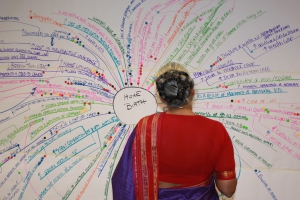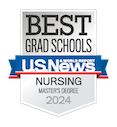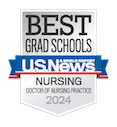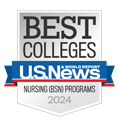Dr. Kane Low Served as Delegate to National Home Birth Consensus Summit
The three-day Summit sought to find common ground in the environment of conflicting opinion currently surrounding the issue of home birth.
 In October 2011, leaders and stakeholders from all sectors of maternity care gathered in Warrenton, VA, to attend the Home Birth Consensus Summit, a three-day meeting intended to establish common ground between those engaged in the national discussion of home birth in order to make the experience of home birth the safest and most positive it can be for the women who choose it. School of Nursing Assistant Professor Dr. Lisa Kane Low, who serves as Coordinator of the U-M Nurse Midwifery Program, was selected to attend the Summit as a delegate.
In October 2011, leaders and stakeholders from all sectors of maternity care gathered in Warrenton, VA, to attend the Home Birth Consensus Summit, a three-day meeting intended to establish common ground between those engaged in the national discussion of home birth in order to make the experience of home birth the safest and most positive it can be for the women who choose it. School of Nursing Assistant Professor Dr. Lisa Kane Low, who serves as Coordinator of the U-M Nurse Midwifery Program, was selected to attend the Summit as a delegate.
Dr. Kane Low described the current environment surrounding home birth as a state of confusion, with conflicting information from various professional organizations resulting in conflicting policies. “There is a polarization around whether or not home birth is a reasonable choice for women to make,” she explained, citing as an example the anti-home birth position statement upheld by the American Congress of Obstetricians and Gynecologists and how it contrasts with the pro-home birth position of the American College of Nurse Midwives (ACNM). “The Home Birth Summit was a way to bring those vested parties to the table in a non-threatening way to bring some kind of consensus about where we are and what we should be doing around the issue of home birth.”
The disagreement, she said, stems in part from poorly designed studies that lump together both planned and unplanned home births thus yielding misleading research results. In addition, she noted that there are two dominant views about homebirth and risk. Most medical providers who are trained to control as much risk as possible, are socialized to believe that a hospital represents the best setting for controlling undue risks. This perspective is challenged by the contradictory belief that factors associated with the hospital, such as technology and surveillance, themselves present risks in the experience of birth.
 “These are two world views about what is most important,” said Dr. Kane Low. “In the middle you have midwifery groups saying women should be educated and informed about risks, but they have the right to make that decision.” Added to the conflict of opinion around the issue is the fact that for the first time in decades the US is seeing a rise in the number of home births. “We are at a tipping point,” Dr. Kane Low said. “People felt this was a good time and space to talk honestly and openly about how we need to think about home birth and how best to promote optimal safety for the mother and her newborn.”
“These are two world views about what is most important,” said Dr. Kane Low. “In the middle you have midwifery groups saying women should be educated and informed about risks, but they have the right to make that decision.” Added to the conflict of opinion around the issue is the fact that for the first time in decades the US is seeing a rise in the number of home births. “We are at a tipping point,” Dr. Kane Low said. “People felt this was a good time and space to talk honestly and openly about how we need to think about home birth and how best to promote optimal safety for the mother and her newborn.”Delegates to the Home Birth Summit were selected based on their national reputation in some aspect of maternity care as well as their familiarity with the conversation of home birth in particular. While the delegates each had a relationship with a professional organization involved in the Summit—Dr. Kane Low’s selection came from her leadership role within the ACNM—the delegates were encouraged to approach the meeting as individuals. “We didn’t have to assume that our professional organizations would be in agreement,” explained Dr. Kane Low. “This allowed us to come to consensus on statements that everybody present could agree to.”
The Summit was facilitated by consultants from the Future Search Network, a non-profit agency known internationally for helping stakeholders with diverse viewpoints untangle complex challenges, broker lasting agreements, and create shared initiatives. At the end of the three-day conversation, attendees produced nine common ground statements relating to maternity care and birth place in the US. In November, the statements were read into the Congressional Record by Congresswoman Lucille Roybal-Allard.
 Each of the nine statements was also assigned a workgroup responsible for moving the initiative forward. Dr. Kane Low directs the workgroup assigned to the statement on interprofessional education. This group looks at developing professional education around the practice of home birth. “I really believe how we educate providers has a lot do with the philosophy instilled around their thinking about choices and opportunities for women in maternity care,” she said.
Each of the nine statements was also assigned a workgroup responsible for moving the initiative forward. Dr. Kane Low directs the workgroup assigned to the statement on interprofessional education. This group looks at developing professional education around the practice of home birth. “I really believe how we educate providers has a lot do with the philosophy instilled around their thinking about choices and opportunities for women in maternity care,” she said.This belief is salient to her role as Coordinator of the Nurse Midwifery Education Program. In an effort to expose students to the full spectrum of maternity care, home birth is addressed in both the program’s curriculum and clinical placement options. “Our students have opportunities to participate in quality home birth practices and to talk about the issues of home birth and out of hospital birth in general,” she said. “The choice of where you work and how you best feel you can meet women’s needs is very individual. We need to provide our students with the opportunities to experience those sites so they can make good decisions about their careers.”
Accompanying Dr. Kane Low to the summit was visiting scholar Marianne Nieuwenhuijze, a researcher at the Midwifery Science Academie Verloskunde in Maastricht, The Netherlands. Nieuwenhuijze was able to bring to the Summit the perspective of a country that has organized maternity care around the assumption that home birth is a viable option. About 35% of women in The Netherlands give birth at home with midwives.





